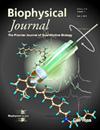一种用于低温电镜研究的新型“生物标签”,基于小的、电子密集的蛋白质Csp1
IF 3.2
3区 生物学
Q2 BIOPHYSICS
引用次数: 0
摘要
用单粒子低温电子显微镜(cryo-EM)技术研究小蛋白质可能具有挑战性,因为它们具有低信噪比,使它们难以识别和分析。在这里,我们研究了使用一个小的(54 kDa)四聚体金属结合蛋白Csp1作为“生物标签”来帮助克服这个问题。我们发现Csp1结构紧凑,稳定,在低温电镜下表现出增强的电子散射和优异的颗粒对比度。因此,我们可以使用标准的冷冻电镜方法确定Csp1到2.98-Å分辨率的结构。我们还测试了Csp1是否可以用作标签或基准来帮助确定与其结合的蛋白质的结构。具体来说,我们分析了一个表位标记的Csp1,该Csp1与来自抗体1D4的约40 kda Fab片段结合。这些配合物的数据得到了配合物(5.70 Å)和结合的1D4 Fab (5.40 Å)的中等分辨率结构。这些结果表明,通过进一步优化,富电子Csp1是一种很有前途的生物标签,可用于低温电镜研究。本文章由计算机程序翻译,如有差异,请以英文原文为准。
A novel "bio-tag" for cryo-EM studies based on the small, electron-dense protein Csp1
Small proteins can be challenging to study by single-particle cryogenic electron microscopy (cryo-EM) techniques because they have low signal-to-noise ratios, making them difficult to identify and analyze. Here we investigated the use of Csp1, a small (54 kDa) tetrameric metal-binding protein, to act as a “bio-tag” to help overcome this problem. We find Csp1 is compact, stable, and exhibits enhanced electron scattering and excellent particle contrast in cryo-EM micrographs. As a result, we could determine the structure of Csp1 to 2.98-Å resolution using standard cryo-EM approaches. We also tested if Csp1 could be used as a tag or fiducial to help determine the structure of a protein bound to it. Specifically, we analyzed an epitope-tagged Csp1 bound to a ∼40-kDa Fab fragment from the antibody 1D4. Data from these complexes yielded medium-resolution structures of the complex (5.70 Å) and the bound 1D4 Fab (5.40 Å). These results suggest that, with further optimization, electron-rich Csp1 is a promising bio-tag for use in cryo-EM studies.
求助全文
通过发布文献求助,成功后即可免费获取论文全文。
去求助
来源期刊

Biophysical journal
生物-生物物理
CiteScore
6.10
自引率
5.90%
发文量
3090
审稿时长
2 months
期刊介绍:
BJ publishes original articles, letters, and perspectives on important problems in modern biophysics. The papers should be written so as to be of interest to a broad community of biophysicists. BJ welcomes experimental studies that employ quantitative physical approaches for the study of biological systems, including or spanning scales from molecule to whole organism. Experimental studies of a purely descriptive or phenomenological nature, with no theoretical or mechanistic underpinning, are not appropriate for publication in BJ. Theoretical studies should offer new insights into the understanding ofexperimental results or suggest new experimentally testable hypotheses. Articles reporting significant methodological or technological advances, which have potential to open new areas of biophysical investigation, are also suitable for publication in BJ. Papers describing improvements in accuracy or speed of existing methods or extra detail within methods described previously are not suitable for BJ.
 求助内容:
求助内容: 应助结果提醒方式:
应助结果提醒方式:


